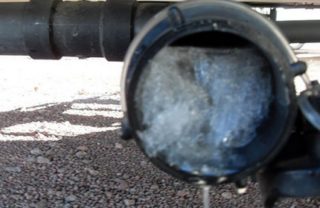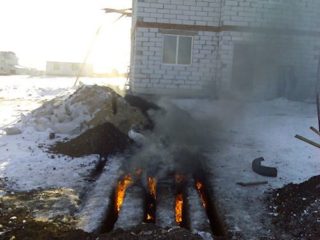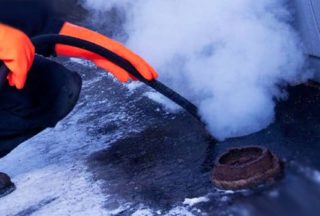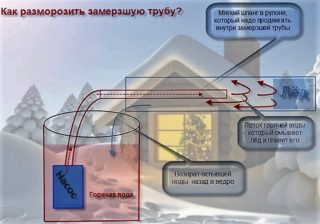If the rules for laying a water supply system in private estates are not followed, the line freezes in cold weather. The water supply to the house is stopped until the problem is corrected. It is necessary to carry out heating of the water supply system underground with extreme caution so as not to provoke a sharp temperature drop, otherwise the pipes will simply break.
How to determine the location of freezing

If the line is frozen underground, an ice plug must be found before the line warms up. To do this, experts recommend doing the following:
- In accordance with the plan for laying communications, it is worth assessing the condition of the soil on the surface. The visually frozen areas are potentially dangerous. Especially if there are turns in such places of the system.
- Open taps at all plumbing points of the house, basement, pool and track where the water flows and where it doesn't. Thus, by the method of elimination, it is possible to identify a frozen section of the water supply system.
- Remove the initial parts of the communication and use the cable to find the area of the ice plug. Move the rope carefully. If the pipes are polymer, it is advisable to put a rubberized tip on the metal cable so as not to scratch the inner surface of the system. As soon as the rope hits the blockage, you need to make a mark on it. An elongated piece of cable is measured from the mark made to its end. Thus, we have an approximate distance from the point where the master is located to the estimated freezing point.
To unfreeze water pipes underground, you need to act as carefully as possible. Otherwise, they may break down and burst. You need to be especially careful with metal-plastic pipes and PVC.
Required tools and materials
To complete the required amount of work, the master prepares a list of required materials and tools. They are selected depending on the method that will be used to warm up the water supply system. More often, masters need the following:
- hair dryer or gas burner;
- hot water bucket (barrel;
- cable;
- salt;
- Esmarch's irrigator;
- firewood and paper;
- shovel;
- electric cable.
The list of tools and materials may increase / decrease / change depending on the area where the ice plug is located.
The main methods of heating pipes with water underground

Polyethylene pipes for water can withstand freezing, which is why they are so popular when laying the street (outdoor) part of the water supply system. And yet, the water in them is capable of turning into ice at fair subzero temperatures, especially if there is no high-quality insulation on the line. You can overcome the problem, unfreeze communication. It will take a lot of time, but if the master acts carefully, the material of the HDPE pipes will remain intact.
Bonfire
The easiest method for heating water pipes in the ground. It is good if the owner of the house has identified an ice formation zone. In this case, you can try to remove the top layer of soil using a crowbar and a shovel. Firewood is laid at the supposed point of the ice and a fire is kindled. You need to burn the fire for at least 2 hours. This should be done during the day in order to have, albeit weak, but the support of the winter sun. Embers can be covered with slate sheets to keep the heat as high as possible. A fire burning before this should warm up the soil and the pipeline.
Hot water
This method works if the water is frozen at the outlet of the well.Hot water, used gradually, helps a lot. Rags are wound on the frozen section of the line and water is started to be poured over it. First, the temperature of the liquid should be up to 15 degrees. With every third liter, it is gradually increased, bringing it to 70 degrees. Gradually, the ice in the pipe will begin to thaw and will open access to running water.
It is strictly forbidden to pour boiling water directly onto the frozen line. This guarantees an instant rush.
Using hot water and pump
- Hot water is poured into a large tank and kept at a constant temperature. You can use a large boiler, a blowtorch, a fire under the container, a pressure cooker or a simple kettle for this.
- Take a hose, the cross-section of which should be less than the diameter of the water pipe, and enter it into the line from the side of the water supply source. The flexible tube should rest against the ice plug.
- The other end is put on the pump and lowered into the barrel. The tap in the house must be open.
- When the equipment is turned on, the unit will supply hot water to the pipeline. Together with it, you need to push the cable deeper, as the ice thaws.
- From time to time it is worth turning off the unit and letting the water drain through the open hole in the pipe.
When the plug is completely defrosted, the water will drain from the tap. After that, you can reassemble the water supply unit at the source.
Brine
The brine is used to neutralize ice in pipes. To do this, you need to prepare a strong solution. Water and salt are mixed in a proportion of 3 tablespoons per 1 liter of water. It is desirable that the liquid is at room temperature.
To complete the work you will need:
- Esmarch's irrigator;
- hydro level;
- hardened steel wire.
You need to do the following:
- The hydraulic level tube and steel wire are connected lengthwise. A bend can be made at the end to provide greater rigidity to the flexible structure. In this case, the edge of the hose should protrude slightly beyond the bend of the wire.
- The other end of the tube is connected to Esmarch's mug.
- The hose is gradually introduced into the plastic / polypropylene / metal water supply system until it stops against the stopper.
- Esmarch's mug is filled with brine and lifted up. The brine flows into the main line and gradually thaws / corrodes the ice. Water must be constantly added to the enema.
It is advisable to put a bucket under the tap, into which melt water will drain. The system must be kept open during work. As soon as the freezing point is overcome, the water will flow by gravity.
Steam generator application

In this case, the sequence of actions will be as follows:
- Water is poured into the reservoir of the steam generator and a hose with a small section (smaller than the diameter of the water pipe) is connected to it.
- The second end of the flexible tube is inserted into the line until it stops.
- A bucket is placed under the open tap of the system to collect melt water, which will drain when steam begins to act on the ice.
- The steam generator is turned on and hot air is fed into the tube.
Complete defrosting of a 10 cm thick cork takes up to 5-10 minutes. You need to pause periodically so that the inner wall of the communication can withstand the generated stress.
If you don't want to mess with the system in this way, you can dig up the frozen section of the line and warm it up with a construction hairdryer or a welding machine.
Preventive measures
To prevent water pipes from freezing in winter, a number of preventive measures should be taken:
- When laying communications, you should first find out the level of soil freezing in the region. It is necessary to mount the line lower so that the pipes do not burst from ice plugs.
- If it is impossible or labor-intensive to do this (for example, for the northern regions, the level of soil freezing is from 1.5 to 2.5 meters or more), you need to qualitatively insulate the system. For this, various materials are used from electric cables to special cylinders made of polystyrene, mineral wool.
- If the house is not used for the winter, it is advisable to completely drain the liquid from the system.
- Often, communications on the purchased site have already been laid. It is worth asking the previous owners at what level the line was mounted. Dig out a section of the line, check the reliability of the laying and insulation of the pipes. While it's spring / summer outside, you can fix the exciting moments.
- Be sure to pay due attention to the areas at the outlet of the water supply from the source and its entrance into the house. They are differential, which means that they constantly collect condensate, which in the future will cause the formation of icing.
Reliable insulation of communication will avoid serious emergency work. The line will not freeze and cause trouble.










At what depth is the author's pipe? My water is supplied from a well at a depth of 2.5 m. The depth of soil freezing is about 2 m. There have been cases of freezing. Experts warmed up the pipe using a large welding machine, connecting electrodes to the beginning and end (at the entrance to the house) of the steel pipe. None of the methods suggested by the author would work.
We are talking not only about metal pipes, but also about plastic pipes! I would have looked like you, in the presence of plastic pipes, warmed up with a welder!
Have you ever tried alcohol? I poured 1 liter of alcohol into the water supply after 2 days, the water went. For information, the freezing point of alcohol is -144 degrees.
in order to warm metal pipes in the ground, a welding machine with a capacity of at least one kilowatt is needed and it weighs more than one ton. our communal services do not have housing and communal services specialists there, all sorts of specialists and geologists and gynecologists work in the leadership and even met a nurse from a kindergarten in the position of a master and all very smart become in the housing and communal services after they are trampled from their main job
Anatoly, in a similar case, saved the steam generator. Well, the method with a fire in Siberia - in case of war.
Of all these methods, the most effective is a steam generator (steam locomotive).